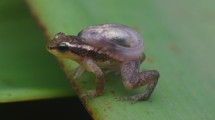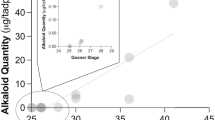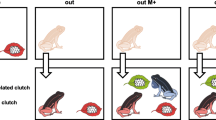Abstract
Aggression between nurserymates is common in animals and often hypothesized to result from proximate resource limitation. In numerous terrestrial frogs, larvae develop in phytotelmata, tiny water bodies where resources are scarce and competition, aggression, and cannibalism are all common between individuals sharing these nurseries. In some species, mothers provision phytotelm-bound young with trophic eggs, a strategy that compensates for low nutrient availability and could allow mothers to reduce costly aggression and cannibalism among nurserymates. We tested this hypothesis using strawberry poison frog (Oophaga pumilio) tadpoles, staging secondary depositions in arenas occupied by residents that had either been food deprived or fed ad libitum. Resident tadpoles were nearly all aggressive and most killed intruders, but aggression was unrelated to resident food deprivation. Unlike most related frogs studied, O. pumilio residents did not cannibalize their victims. This result supports the hypothesis that proximate food limitation and aggression can be independent.
Significance statement
Aggression and cannibalism are common in the resource-limited nurseries in which many young animals develop. An intuitive hypothesis for this is that individuals are aggressive because they are hungry. Although this hypothesis has usually been supported in birds, we found no support for it in a test we conducted in a terrestrial frog that feeds its young with trophic eggs. Resident tadpoles fed ad libitum were just as aggressive to staged intruders as those that were food-deprived, and were just as likely to kill intruders. Residents did not cannibalize their victims. These results suggest that hunger-independent aggression in young animals is taxonomically widespread, and demonstrates an important ecological constraint on parents: they cannot prevent fatal aggression, they cannot “feed” tadpoles to older siblings, and thus, they cannot use occupied rearing sites.

Similar content being viewed by others
References
Brown JL, Morales V, Summers K (2009) Tactical reproductive parasitism via larval cannibalism in Peruvian poison frogs. Biol Lett 5:148–151
Brown JL, Morales V, Summers K (2010) A key ecological trait drove the evolution of biparental care and monogamy in an amphibian. Am Nat 175:436–446
Brust DG (1990) Maternal brood care by Dedrobates pumilio: a frog that feeds its young. PhD dissertation, Cornell University, Ithaca, NY
Brust DG (1993) Maternal brood care by Dedrobates pumilio: a frog that feeds its young. J Herpetol 27:96–98
Caldwell JP, de Araújo MC (1998) Cannibalistic interactions resulting from indiscriminate predatory behavior in tadpoles of poison frogs (Anura: Dendrobatidae). Biotropica 30:92–103
Crespi BJ (1992) Cannibalism and trophic eggs in subsocial and eusocial insects. In: Crespi BJ (ed) Cannibalism: ecology and evolution among diverse taxa. Oxford University Press, Oxford, pp 176–213
Donnelly MA (1989) Effects of resource supplementation on space-use patterns in Dendrobates pumilio. Oecologia 81:212–218
Drummond H (2001) The control and function of agonism in avian broodmates. Adv Stud Behav 30:261–360
Drummond H (2002) Begging versus aggression in avian broodmate competition. In: Wright J, Leonard M (eds) The evolution of begging. Kluwer Academic Publishers, Dordrecht, NL, pp 337–360
Dugas MB, Richards-Zawacki CL (2016) Conspicuous and cryptic morphs of a polytypic poison frog differ in reproductive output because of differences in tadpole performance, not parental effort. Ethol Ecol Evol (published online, doi:10.1080/03949370.2015.1076527)
Dugas MB, Wamelink CN, Richards-Zawacki CL (2015) Both sexes pay a cost of reproduction in a frog with biparental care. Biol J Linn Soc 115:211–218
Dugas MB, Wamelink CL, Killius AM, Richards-Zawacki CL (2016) Parental care is beneficial for offspring, costly for mothers, and limited by family size in an egg-feeding frog. Behav Ecol 27:476–483
Forbes LS (1990) Insurance offspring and the evolution of avian clutch size. J Theor Biol 147:345–359
Gosner KL (1960) A simplified table for staging anuran embryos and larvae with notes on identification. Herpetologica 16:183–190
Gray HM, Summers K, Ibáñez RD (2009) Kin discrimination in cannibalistic tadpoles of the green poison frog, Dendrobates auratus (Anura, Dendrobatidae). Phyllomedusa 8:41–50
Haase A, Prohl H (2002) Female activity patterns and aggressiveness in the strawberry poison frog Dendrobates pumilio (Anura: Dendrobatidae). Amphibia-Reptilia 23:129–140
Lessels CM, Boag PT (1987) Unrepeatable repeatabilities: a common mistake. Auk 104:116–121
Maple MM (2002) Maternal effects on offspring fitness in Dendrobates pumilio, the strawberry poison frog. PhD dissertation, University of Kentucky, Lexington, KY
Mock DW (1985) Siblicidal brood reduction: the prey size hypothesis. Am Nat 125:327–343
Mock DW, Parker GA (1997) The evolution of sibling rivalry. Oxford University Press, Oxford, UK
Mock DW, Lamey TC, Ploger BJ (1987) Proximate and ultimate roles of food amount in regulating egret sibling aggression. Ecology 68:1760–1722
Morandini V, Ferrer M (2015) Sibling aggression and brood reduction: a review. Ethol Ecol Evol 27:2–16
Muralidhar P, De Sá FP, Haddad CFB, Zamudio KR (2014) Kin-bias, breeding site selection and female fitness in a cannibalistic Neotropical frog. Mol Ecol 23:423–463
Osorno JL, Drummond H (2003) Is obligate siblicidal aggression food sensitive? Behav Ecol Sociobiol 54:547–554
Perry JC, Roitberg BD (2006) Trophic egg laying: hypotheses and tests. Oikos 112:706–714
Pexton JJ, Meyhew PJ (2002) Siblicide and life-history evolution in parasitiods. Behav Ecol 13:690–695
Poelman EH, Dicke M (2007) Offering offspring as food to cannibals: oviposition strategies of Amazonian poison frogs (Dendrobates ventrimaculatus). Evol Ecol 21:215–227
Prӧhl H, Berke O (2001) Spatial distributions of male and female strawberry poison frogs and their relation to female reproductive resources. Oecologia 21:215–227
Reynolds JD, Goodwin NB, Freckleton RP (2002) Evolutionary transitions in parental care and live bearing in vertebrates. Philos T Roy Soc B 357:269–281
Rojas B (2014) Strange parental decisions: fathers of the dyeing poison frog deposit their tadpoles in pools occupied by large cannibals. Behav Ecol Sociobiol 68:551–559
Schulte LM, Lӧtters S (2013) The power of the seasons: rainfall triggers parental care in poison frogs. Evol Ecol 27:711–723
Simmons RE (1988) Offspring quality and the evolution of Cainism. Ibis 130:339–356
Stynoski JL (2009) Discrimination of offspring by indirect recognition in an egg-feeding dendrobatid frog, Oophaga pumilio. Anim Behav 78:1351–1356
Stynoski JL (2012) Behavioural ecology of parental care in a dendrobatid frog (Oophaga pumilio). PhD dissertation, University of Miami, Miami, FL
Stynoski JL, Torres–Mendoza Y, Sasa–Marin M, Saporito RA (2014) Evidence of maternal provisioning of alkaloid–based chemical defences in the strawberry poison frog Oophaga pumilio. Ecology 95:587–593
Summers K, McKeon CS (2004) The evolutionary ecology of phytotelmata use in neotropical poison frogs. In: Lehtinen RM (ed) Ecology and evolution of phtyotelm-breeding anurans. Misc Publ Mus Zool Uni Mich 193:55–73
Summers K, Symula R (2001) Cannibalism and kin discrimination in tadpoles of the Amazonian poison frog, Dendrobates ventrimaculatus, in the field. Herpetol J 11:17–21
Summers K, McKeon CS, Heying H, Hall J, Patrick W (2007) Social and environmental influences on egg size evolution in frogs. J Zool 271:225–232
Tarvin RD, Santos JC, O’Connell LA, Zakon HH, Cannatella DC (2016) Convergent substitutions in a sodium channel suggest multiple origins of toxin resistance in poison frogs. Mol Biol Evol 33:1068–1081
van Alphen JJM, Visser ME (1990) Superparasitism as an adaptive strategy for insect parasitoids. Annu Rev Entomol 35:59–79
Wells KD (2007) The ecology and behavior of amphibians. University of Chicago Press, Chicago
Acknowledgments
We thank Corinne Richards-Zawacki and the LaSelva Biological Station for support during this project. This work was funded by a grant from the Louisiana Board of Regents to MBD (LEQSF-EPS(2013)-PFUND-332). MBD was supported on a grant from the National Science foundation (Award 1146370). David Pfennig and two anonymous reviewers provided insightful comments that greatly improved the quality of this manuscript.
Author information
Authors and Affiliations
Corresponding author
Ethics declarations
Ethical approval
All applicable international, national, and institutional guidelines for the care and use of animals were followed. All procedures involving live animals were approved by Tulane University’s Institutional Animal Care and Use Committee (R0382-R1). The Ministerio de Ambiente, Energía y Telecomunicaciones of Costa Rica approved all methods and issued the appropriate permit (053-2013-SINAC).
Additional information
Communicated by D. W. Pfennig
Electronic supplementary material
Below is the link to the electronic supplementary material.
ESM 4
(PDF 72 kb)
(MPG 7872 kb)
(MPG 6744 kb)
(MPG 8016 kb)
Rights and permissions
About this article
Cite this article
Dugas, M.B., Stynoski, J. & Strickler, S.A. Larval aggression is independent of food limitation in nurseries of a poison frog. Behav Ecol Sociobiol 70, 1389–1395 (2016). https://doi.org/10.1007/s00265-016-2148-5
Received:
Revised:
Accepted:
Published:
Issue Date:
DOI: https://doi.org/10.1007/s00265-016-2148-5




